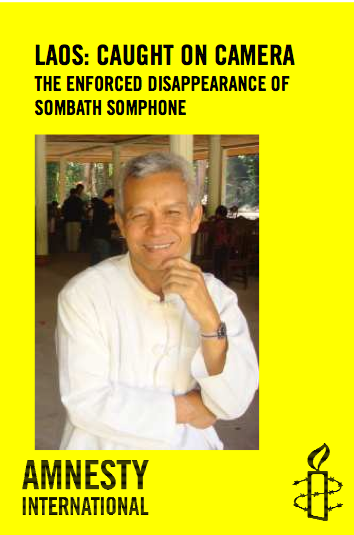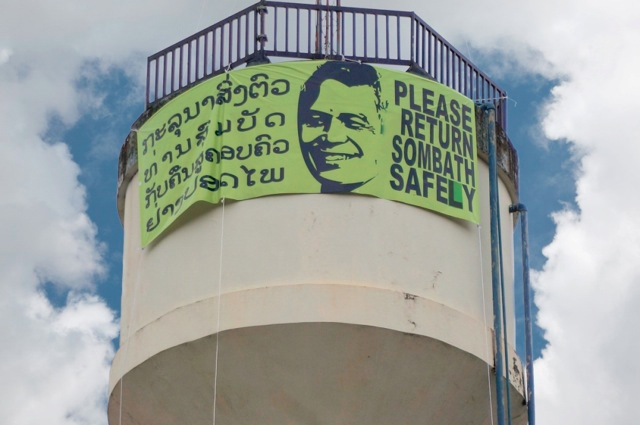ABC Radio Australia: 14 June 2013
You can listen to the ABC interview with Amnesty International here, or read the transcript below.
It’s six months since the disappearance of prominent Lao civil society leader, Sombath Somphone. His apparent abduction from outside a police post in the capital, Vientiane, was caught on closed circuit television.
Expressions of concern about his fate have come from across the region, as well as the United States and the European Union.
The Lao authorities say they are continuing to investigate the case, but there’s been no progress to date.
Now it seems further analysis of the CCTV footage has revealed fresh details about just what happened on the evening of the 15th December 2012.
They’re contained in a report from Amnesty International called ‘Caught on camera – the enforced disappearance of Sombath Somphone’.
Presenter: Richard Ewart
Speaker: Rupert Abbott, Laos researcher, Amnesty International
ABBOTT: Well in our report Caught on Camera, we considered three areas really, we considered the background for Sombath’s disappearance, what happened before that day on the 15th of December. And we found that really there are signals that the authorities were trying to restrict him in society in the run-up to Sombath’s disappearance. Then we’d looked at what happened on the actual day, and you mentioned the CCTV footage of Sombath being stopped at a police post then taken away by a pick-up truck with flashing lights. And in our analysis of that CCTV footage which his family had managed to get a copy of, we have found that there’s also a gunman at the scene, there appears to be a gunshot fired at the scene. And the reason that’s so important is that the police have tried to say that the situation was normal, that there was nothing untoward going on. Now for them to be saying that when there was a gunman at the scene among all the other things that happened, is now appearing absurd. And we’ve also considered the aftermath, the investigations by the police that have been entirely inadequate, these bizarre conclusions that the situation was normal for someone to be stopped a police post and then taken away with a gunman at the scene. And also this rejection of assistance that other countries have been offering, for example to look at the original CCTV footage, do an analysis, find the number plates, try to identify those individuals at the scene. Amnesty International we tried to visit Laos to discuss this case among other things, and we tried to meet with senior Laos officials outside of the country, and our offers to meet have been rejected. But more importantly technical assistance from other countries has been rejected.
EWART: Can I ask you a little bit more about the gunman in this video, do we know why there would have been a gunman there? You say there was a shot fired, was it aimed at Sombath or what, is it not clear?
ABBOTT: No the gunshot was fired in the air and of course we can’t be sure why that gunman was there. What happened was that Sombath was stopped at a police post by police, he got out of his car, his car was then driven off by someone. He was then taken into a car with flashing lights that arrived. Then a motorcycle appeared before that car with flashing lights, the passenger on the motorcycle fired the gun into the air and drives off and the car appears to then follow the motorcycle and drives off as well. And the gunshot may have been fired as a warning, that it was time to go, as a threat to potential witnesses, it’s hard to say. But what is clear is that cannot be normal for someone to be firing a gunshot in the air at a police post on a busy road in central Vientiane, the capital of Laos. And for the police to say that the situation was normal is looking more and more absurd.
EWART: Now you talked about your attempts to hold meetings with Lao officials, I suppose it’s not exactly unusual for the Lao government to refuse to meet and talk to people like yourselves about this sort of case or indeed about much else that’s going on inside Laos. Should we be talking about a conspiracy theory here or should we believe that they are as a government investigating even if they’re not prepared to go public about it?
ABBOTT: Well the police have released reports over the last few months as to where their investigation is going, what they’re found, really showing the investigation’s been inadequate. I mean they haven’t even mentioned this gunman at the scene for example, as I say he did fire a gunshot into the air. But also it’s six months on now, Laos’ reputation is taking a real battering over this and the matter’s not going to go away. So to not accept assistance for reasons of national pride for example is looking worse and worse really. Laos probably doesn’t have the technical capacity that other countries such as the US can offer to analyse this footage. This is as good evidence of a disappearance as you’re ever going to find. The fact it was caught on a traffic camera and then the family then managed to get a copy of. So for the authorities to be refusing assistance is really concerning, and Amnesty International would suggest that it’s looking like a cover-up in that regard.
EWART: And the fact that the family do have a copy of the video and I presume that was, for want of a better term, leaked to them, does that suggest there are those within the Lao authorities who perhaps know more than the government are prepared to let on and are concerned about this?
ABBOTT: Well the family was able to get a copy of the video, and just to be clear this is a video recorded on a mobile phone or similar devices from the screen. That’s why the video that’s available online that anyone can view is a bit blurry. So what’s required is for the authorities to release the original footage, and the family are asking for that, but also to allow others to provide that technical assistance to analyse that original footage, which would not be so blurry. What happened was that the family went to the police station soon after Sombath had disappeared and came across this footage and were allowed to copy it. I think it suggests that not everybody in the Lao authorities is involved, indeed we’re not suggesting that this necessarily comes as an order from the top. But the fact that police were there, they did nothing to stop him being taken away, suggests that the authorities are involved in some way. So I think it was more a case the police on duty at the time, the family then were given a copy of the video probably didn’t know what had happened and didn’t know that perhaps they were meant be part of a cover up.
EWART: And as far as the investigation is concerned, this is as I understand it doesn’t need to be confined to Laos anyway because of the nature of what has happened here it is possible for other countries to get involved?
ABBOTT: Well that’s right, the onus is on Laos to investigate this properly. In our report, Caught on Camera, the recommendations we made to the Lao government, well find him, order, demand his release that anyone in the Lao authorities who has him to release him. But setup a new commission to investigate what’s happened, find out where he is, why he was taken and make sure he’s released and returned safely to his family and bring to justice those who are responsible for taking him. The current commission has clearly done an inadequate investigation, it’s a police commission investigating police at the scene, so let’s setup an independent commission to do these investigations and do them properly. But you’re absolutely right, an enforced disappearance, that’s a disappearance, someone being abducted if you like with the involvement of the authorities, as well as being a very serious human rights violation, is also unlike some human rights violations, considered a crime under international law, which means that other countries under international law can actually undertake investigations and exercise universal jurisdiction and bring to justice those suspected of being responsible for this abduction. So that is something open to other countries, to the international community and something we set out in this report that they should consider moving forward if the Lao government will not do these investigations properly and find him.
Related

